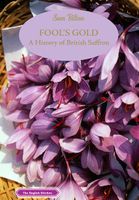Advertisement
Chapter Six
Appears in
By Sam Bilton
Published 2022
- 1 Harrison (1994), pp. 355-6.
- 2 Clarke (1887), p. 14. Clarke says the word ‘croaker’ used to describe a grumpy person could well be derived from ‘croker’.
- 3 Norden (1840), p. 8.
- 4 Thirsk (1997), p. 252.
- 5 Clarke (1887), pp. 9-16.; Fitch (1895); ‘Died’, Cambridge Chronicle and Journal, 8 June 1827.
- 6 Clarke (1887), pp. 9-16. There was farmer called John Knott living Moor Lane in Duxford in the 1841 census who was born around 1795, who would be the right age to be the croker’s grandson. Interestingly, his eldest son, also called John, was born in 1828, a year after the last saffron grower died. This John Knott died in 1875.
- 7 Harvey (1678), p.120. Harvey also notes that India-Saffron (which he calls Crocus Orient) was just 3s 6d per pound. Whether this was true saffron though is anyone’s guess.
- 8 Braybrooke (1836), p. 146; Thirsk (1997), pp. 147-8.
- 9 Alexander (1770), p. iii, pp. 88-92. Alexander embarked on his saffron experiment as he had heard of a ‘lunatic who swallowed a very large quantity of it without being hurt’. This led him to the conclusion that saffron was pretty ineffective as a medicine. After his own trials though he did concede that his excrement was strongly tinged with saffron but that was about the only discernible effect he could detect.
- 10 Clarke (1887), p. 13
- 11 Beeton (1861), p. 1055.
- 12 Leyel (1938), p. 228. Both Cato and Pliny valued coleworts (cabbages and the like belonging to the brassica family) for their medicinal qualities. In Acetaria: A Discourse of Sallets (1699) John Evelyn also praised the cabbage for its effectiveness against intoxication. A ‘lohoch’ was a type of medicine that, as Leyel explains on p. 15, is ‘thicker in consistency than a syrup but not as thick as an electuary’.
- 13 Francis & Ramandi (2021), p. 25-26; Thirsk (1997), p. 236; Panda (2018), pp. 18-22.
- 14 Du Maurier (2016), Chapter 8, ‘Tinners’; Heard (1984), p. 100.
- 15 Shepro (2021), p. 308.
- 16 Thirsk (1997), p. 140.
- 17 Francis, (2020), Preface.
- 18 Thirsk (1997), p. 225.
- 19 The numbers of brown hares in the UK declined drastically during the twentieth century although there are some indications that their numbers may slowly be increasing. (See https://www.gwct.org.uk/research/species/mammals/brown-hare/trends-in-brown-hare-numbers/)
- 20 Dandan et al (2020).
- 21 Souret and Weathers (2000), pp. 25-35.
- 22 Harrison (1994), p. 348
- 23 Shepro (2021), p. 308.
- 24 Blith (1649), p. 248.

